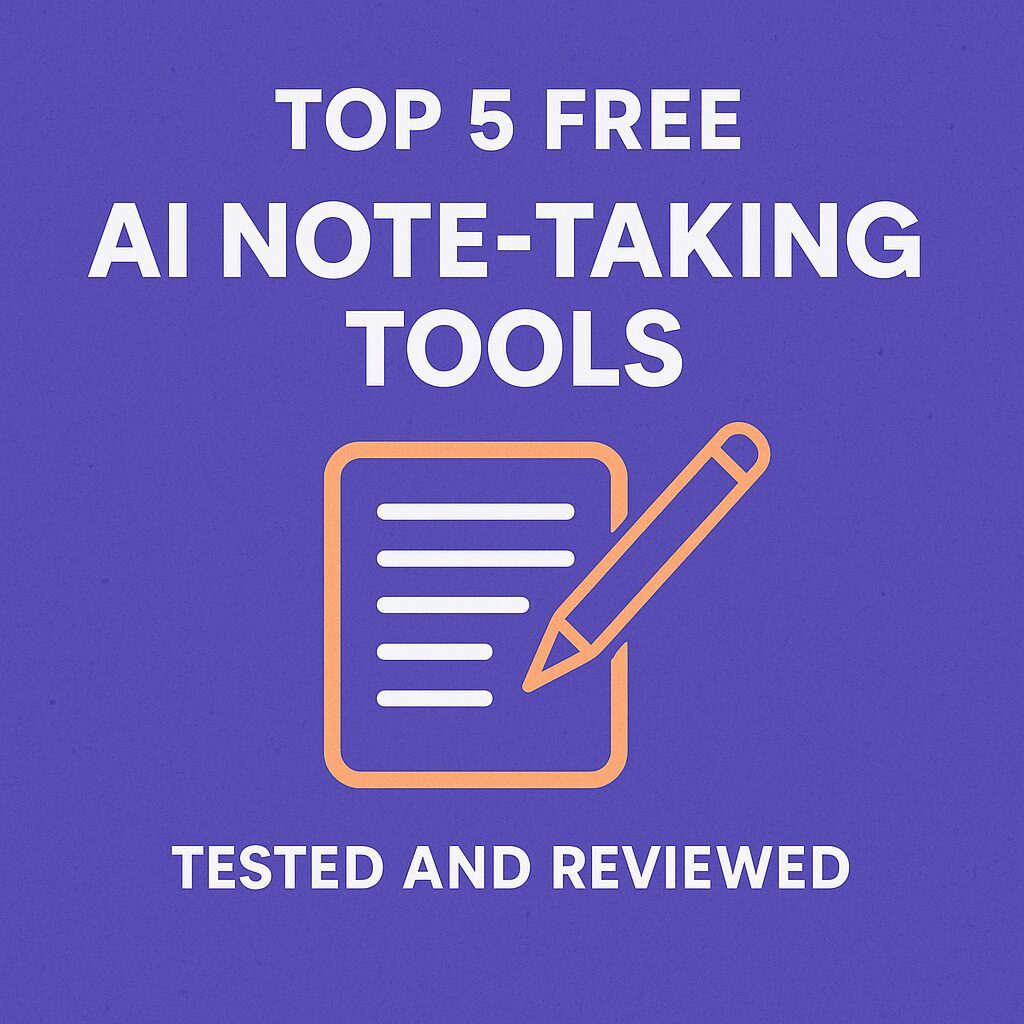2025 has been a whirlwind of a year for free AI note taking tools so far. While most AI meeting assistants have been around for a good few years already, this year seems to be somewhat of a breakout year for widespread adoption.
In May, heavyweight note taker Granola received $43 million in a Series B funding round. Around the same time, productivity giant Notion released its AI meeting notes, and just a couple of weeks later, OpenAI jumped on the bandwagon with ChatGPT Record.
Every five seconds there seems to be news bombshells going off in the space. But everyday people are still asking the same question: what’s the best free AI note taking tool out now?
I’ve spent countless hours testing AI note takers for my job, and while my role at tl;dv may come with a pinch of bias, the truth is I am an individual user too. I don’t have a paid plan for any of the AI meeting assistants I use or test. I’m also searching for the best tool for AI notes, summaries, and transcripts.
Here, I’ve gathered the top 5 free AI note taking platforms with free plans that I’ve personally tested and already reviewed (which I’ve linked below). I’ll cover my experience using each tool, some real everyday user feedback, and a quick glance at their paid plans to see whether they’re worth upgrading to. Let’s dive in!
TL;DR: The 5 Best Free AI Note Taking Tools in 2025
2025 has been a big year for free AI note takers—with huge funding rounds, new product launches, and mainstream adoption across education and enterprise.
After testing dozens of tools, here are the top 5 truly useful free plans:
tl;dv – Most generous free plan for Google Meet, MS Teams, and Zoom users. Includes unlimited video recordings, transcripts, and AI summaries.
Fireflies – Great for audio uploads and it provides unlimited transcripts, though there’s no video recording.
Fathom – Completely free for individuals but lacks the finesse of other tools.
Tactiq – Transcribes meetings live across a range of platforms without a bot. However, there is no video recording and transcripts are notably weak. Free plan includes just 10 AI summaries/month.
Otter.ai – Solid for lectures and in-person audio, but the free plan feels more like a demo in 2025. Also doesn’t have video recording.
None are perfect, but some give you a lot without paying. Detailed pros, cons, and upgrade info in the full post below.
Reviewed and Tested: The 5 Ultimate Free AI Notetakers in 2025
This list consists of 5 tried and tested tools that provide you with the most value without having to spend anything. They are:
- tl;dv
- Fireflies
- Fathom
- Tactiq
- Otter
Let’s dive into each one.
1. tl;dv
If you’re a Google Meet, Zoom, or MS Teams user (who isn’t?), tl;dv is hands down the most generous free plan on the market right now. Unlike many tools that lure you in with a trial and then strip away all the good stuff, tl;dv gives you actual usable features without asking for your credit card. The UI is clean, intuitive, and doesn’t get in your way—something I’ve come to appreciate after testing far too many clunky dashboards.
From real-time highlights and timestamps to automatic language detection (across 40+ languages) and speaker labels, its core free feature set includes a lot of things that competitors will charge you for. You can also tag key moments during calls, edit recordings, and organize everything in a sleek video library.
What’s great about tl;dv is that you get unlimited video and audio recordings, transcripts, and AI moment summaries.
Free Plan Benefits
- Unlimited video recordings on Google Meet, Zoom, and MS Teams.
- Unlimited meetings and viewers.
- Unlimited transcription in 40+ languages.
- Unlimited AI moment summaries.
- 10x AI meeting notes.
- 10x Ask tl;dv AI credits.
- 10x multi-meeting AI reports.
- 5 video uploads.
- Automatic speaker recognition.
- Slack, email, and calendar integrations.
- Auto-recording of meetings.
- Clip and embed key moments.
- Meeting views tracker.
- Enhanced GDPR and consent management features.
This is the kind of free plan that feels like it was actually built for users—not just as a teaser for the paid version.
It’s a tool that anybody can set up in 5 minutes and get transcripts on every meeting they ever run forever. This is even the case if you’re not attending the meeting. tl;dv can go on your behalf so you still get notes. Just make sure the admin lets your bot in.
Free Plan Drawbacks
tl;dv’s free plan is great to get you started with meeting transcription, but it doesn’t give access to its most in-depth features. Things like multi-meeting memory and intelligence, sales coaching, and unlimited Ask tl;dv AI credits are all accessible only in the paid plans.
Additionally:
- tl;dv isn’t yet compatible with other video conferencing platforms like Webex, BlueJeans, and GoToMeeting.
- The only free integrations available are Slack, email, and calendars. For 5,000+ more, you’ll need to upgrade to Pro.
- Recordings are archived after 3 days.
tl;dv’s Pricing and Upgrades: How Much Does It Cost?

tl;dv has four plans:
- Free Forever ($0)
- Pro ($18)
- Business ($39)
- Enterprise (Custom)
All prices are per user per month when billed annually.
As you can see, the upgrade to Pro nets you unlimited AI meeting notes, Ask tl;dv AI credits, and multi-meeting reports. It also provides unlimited file uploads, email follow-up drafter, custom bot appearance, and over 5,000 integrations, including all your favorite CRMs. You can see the full list yourself here.
The Business plan takes things a step further with sales-specific features like AI objection handling, AI multi-meeting speaker insights, and sales playbook monitoring. It also includes AI sales coaching, an MCP server, as well as API & webhooks, deeply customizable CRM integrations, and multi-team management.
The Enterprise plan tops things out with privately hosted AI, a dedicated customer success manager, and advanced team and data management for admins.
When viewing the full suite of features, it makes it easy to see why they offer video recording and transcripts for free. There are so many powerful features designed to plumb the depths for meeting insights that transcription alone is just the standard.
Real User Reviews: What Do Everyday tl;dv Users Think?
We’ve gathered reviews for tl;dv across three unbiased third-party platforms: G2, ProductHunt, and ChromeStore.
- On G2, tl;dv scores 4.7/5 from 397 reviews.
- On ProductHunt, it scores 4.6/5 from 233 reviews.
- On ChromeStore, it scores 4.6/5 from 486 ratings.
That means, tl;dv’s weighted average is 4.63/5 from 1,116 reviews. In other words, it has a 92.6% satisfaction rate.
Below, I’ll show you several reviews that all talk about the free plan in particular. Let’s start with Horacio on G2.

Horacio is a CEO of a small business and he’s been using tl;dv for a while now, starting on the free plan and recently upgrading to the paid version. He describes the difference between the two as “fascinating.”
As a market researcher, he says, “It’s incredibly useful for capturing insights from interviews and analyzing the transcripts in detail.” He also calls the transcripts “flawless—even in different languages.”
His one feature request can be boiled down to sentiment analysis. Unfortunately, there’s a reason sentiment analysis isn’t offered by tl;dv. It’s against the law in the EU (where tl;dv is registered), particularly the EU AI Act, which tl;dv strives to be compliant with.
Next up, Giri S. refers to tl;dv as one of the best meeting assistants they’ve ever used, particularly highlighting how the “free plan makes it accessible to individuals and small teams.”

Giri gives tl;dv a 4.5/5 rating on G2, identifying features like meeting notes, multi-language transcriptions, and CRM integrations as super helpful. They also love how tl;dv “empowers users to focus on meaningful work rather than administrative tasks.”
One of their main dislikes is the lack of mobile app. Fortunately for Giri, the mobile app is being built as we speak. It’s one of the top priorities for the tl;dv team.

Over on ProductHunt, a founder named Michael claimed the launch video alone got him to download it.
Honestly, we can’t blame him. Check it out here.
Over on ChromeStore, the four most recent reviews are all 5 stars. Users praise the transcript quality, the efficiency of the bot, the great customer support, and even Czech language transcription accuracy!

In short, customers are happy. tl;dv does exactly what it says on the tin, and you can get started with unlimited free transcripts in about 3 minutes.
2. Fireflies
Fireflies has been around for a while and was one of the early players in AI meeting transcription. It’s platform-agnostic, meaning you can use it with Zoom, Google Meet, Microsoft Teams, Webex, or even by uploading pre-recorded audio. That flexibility makes it a great fit for podcasters, researchers, or anyone who wants searchable transcripts from various sources.
Where it really stands out is AskFred—Fireflies’ ChatGPT-style assistant that can summarize meetings and answer questions based on your calls. It’s genuinely clever. The problem? Once your trial ends, a lot of that cleverness disappears behind a paywall, including some basics like video recording.
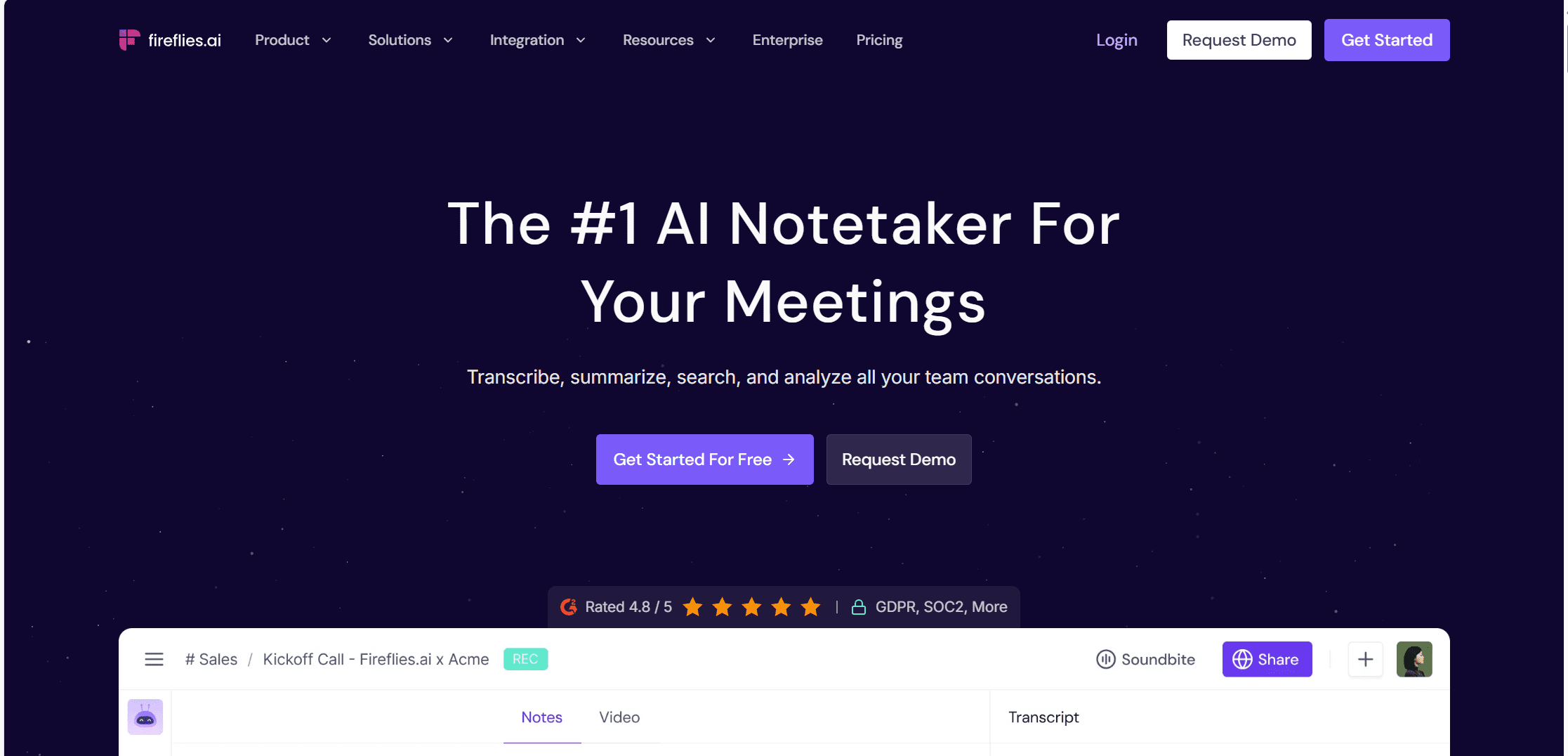
Free Plan Benefits
- Unlimited transcription
- Upload and transcribe audio/video files
- 800 mins of storage (with usage caveats)
- Limited AI credits for AskFred
- Limited AI summaries
- Real-time notes and live transcription
- Mobile app
- Searchable transcripts and a neat notes interface
Fireflies’ free plan is useful, there’s no doubt about it. The mobile app is a great addition and the unlimited transcripts mean that you can get a hard copy of everything discussed in all your meetings, but it lacks video and cannot automatically detect languages mid-call.
Free Plan Drawbacks
- No video recording (you can get it in the trial but this is temporary)
- AskFred credits are limited and run out quickly
- CRM integrations, collaboration features, and analytics require a paid plan
- Transcript accuracy isn’t the best in noisy environments or with multiple speakers
- No automatic language detection
Fireflies positions itself as free, but the moment your trial ends, you’re left with an audio upload tool and some basic features. It’s not bad, it’s just a bit misleading if you’re expecting a full meeting assistant out of the box.
Fireflies’ Pricing and Upgrades: How Much Does It Cost?

Fireflies has four plans:
- Free ($0)
- Pro ($10)
- Business ($19)
- Enterprise ($39)
All pricing is per user per month when billed annually.
The Pro plan unlocks unlimited AI summaries, the ability to download transcripts, summaries, and recordings, as well as talk-time analytics for your calls. This plan also unlocked all Fireflies’ integrations.
Business plans add even more: unlimited storage, video recording, team analytics, and API access. The Business plan also highlights Conversation Intelligence.
For Enterprise, you’ll get the usual SSO, private storage, custom data retention, dedicated account manager, and guaranteed HIPAA compliance.
Real User Feedback: What Do Fireflies’ Everyday Users Think?
- On G2, Fireflies scores 4.8/5 from 707 reviews.
- On ProductHunt, it scores 4.4/5 from 113 reviews.
- On ChromeStore, it scores 4/5 from 59 reviews.
- On Capterra, it scores 4.3/5 from 12 reviews.
- On TrustPilot, it scores 4.4/5 from 226 reviews.
The total weighted average of Fireflies is 4.63/5 from a total of 1,117 reviews. That’s almost exactly the same as tl;dv.
As with tl;dv, I searched first by “free” to see what real everyday users think of Fireflies as their free AI note taker tool. The first review was very positive.

Ken S., a Business Development Manager finds Fireflies to be a “tremendously helpful tool.” He loves how the AI suggests deliverables and follow up actions post-meeting. It helps with overall clarity for all involved. Ken is currently on the free plan, but is enjoying Fireflies so much that he intends to upgrade to one of the paid plans. He just hasn’t made his mind up yet which one.
He does list several things where Fireflies could improve. Firstly, he highlights speaker recognition as a drawback. He claims that unless speakers identify themselves then the AI won’t be able to name them. I’m not 100% sure if this is true, but it’s certainly not the case with tl;dv.
Ken also says he struggles to get Fireflies to join his MS Teams meetings through his calendar. It’s fine for other platforms but struggles with MS Teams for some reason. Something to keep in mind if you’re a Teams user.
The second most recent free plan review on G2 is not so kind.

This verified user gave Fireflies 0 stars on the 9th of April, 2025. He praised the idea and was drawn to the free trial based on the promise of automatic meeting transcription with smart AI summaries and integrations, however, he disliked “almost everything after sign-up.”
Specifically, he claims he was “charged for three months of a Business plan and AI credits without clear consent, usage, or even a single billing email or invoice.” He only noticed charges later when he was reviewing his credit card. The Fireflies customer support refunded him one month’s pay, but not the other two unused months.
He also claims the “downgrade process was hidden and confusing.” On top of all this, “the integration with Notion never worked.” This was one of the primary reasons he wanted to use Fireflies in the first place.

Alon C. finds Fireflies simple to use with great meeting summaries and nice navigation. He highlights the fact that you can search through transcripts using keywords, tags, or filters so it’s super easy to find what you’re looking for without rewatching the entire call.
However, Alon draws attention to the free plan’s limitations, claiming that “many useful features (like advanced summaries, integrations, or longer storage) are behind a paywall.”
Over on Capterra, Viktoriya says she finds herself “transitioning away from Fireflies” primarily because they can’t keep up with the free plans of the competition, whereas Ben Ferraira writes on ChromeStore that he doesn’t know how he ever did meetings without Fireflies.
In short, while Fireflies’ reviews are generally good (equal to tl;dv by weighted average), you’ll find that tl;dv’s free plan reviews are much stronger than Fireflies’. While their free plan has improved in recent years, it’s still not quite challenging for the throne.
3. Fathom
Fathom used to be a Zoom-only AI notetaker, but it’s since branched out into MS Teams and Google Meet too. If you’re in the market for free AI note taker tools, Fathom is one of the most likely to show up. That’s because it specializes in being free for individuals; that’s its tagline. It also has phenomenal reviews (which we’ll take a look at soon), but it should be noted that in the early days, Fathom rewarded users for leaving positive feedback so take these high scores with a grain of salt.

Free Plan Benefits
- Unlimited meeting recordings, transcription, and storage—available across Zoom, Meet, and Teams, and in 25+ languages
- Unlimited recording length
- AI-powered meeting summaries, plus highlight clips you can share during or after calls
- Searchable transcripts with keyword filtering across all your recorded meetings
- 5 “Ask Fathom” NLP chat queries
This feels like a tool designed for actual individual users, not just as a demo for upgrades.
Free Plan Drawbacks
- Limits on AI features—advanced summaries, auto action items, follow-up emails, and Ask Fathom are capped at 5 calls/month
- Only records while you’re in the meeting—no always-on bot to join in your absence
- Not available for Webex, GoToMeeting, or BlueJeans
- No shared folders, team-wide search, keyword alerts, or retention policies on the free plan
- Some users mention timestamp glitches, bot interruptions, and occasional CRM sync hiccups
Fathom’s free plan is great if you’re looking for free AI note taker tools, but if you want the more advanced or team-based features, you’ll need to upgrade. The free plan is specifically individual-only.
Fathom’s Pricing and Upgrades: How Much Does It Cost?
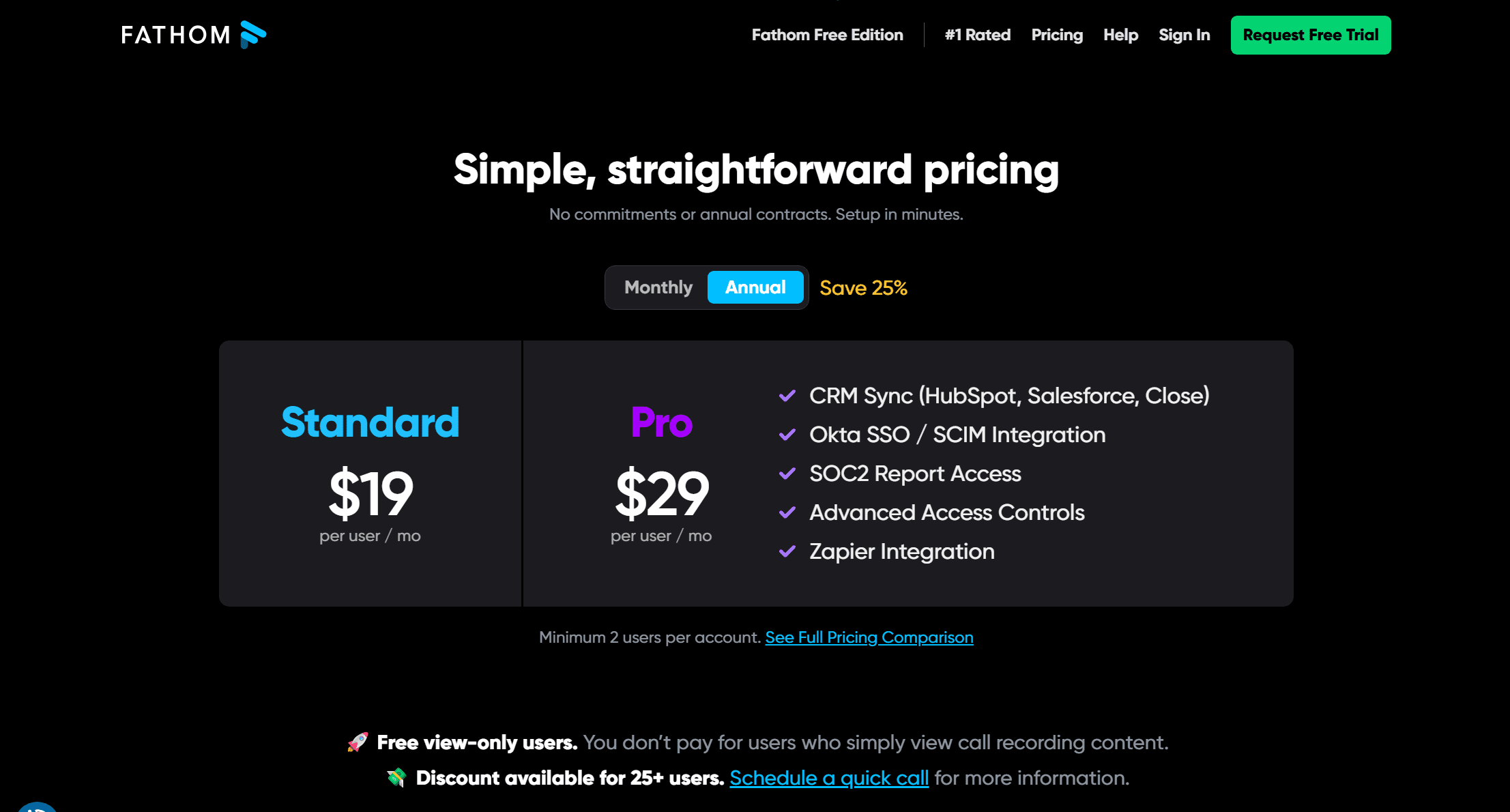
Fathom prides itself on simple, straightforward pricing, but I actually found it far more confusing than it needed to be. Based on the screenshot above, you’d be forgiven for thinking there were just two paid plans. There are actually 3 paid plans and 1 free, but Fathom doesn’t even have a link to their pricing page from the homepage, making you jump through hoops to find what you’re looking for.
- Free ($0)
- Premium ($15)
- Team Edition Standard ($19)
- Team Edition Pro ($29)
All prices are per user per month when billed annually.
For the team plans, Fathom requires a minimum of 2 users per account, so it’s actually $38 per month minimum. There are discounts available if you have a team with more than 25 users joining.

You can see better in the screenshot above. Fathom’s free plan includes unlimited free recordings, transcripts, and storage, but it only provides useful AI for 5 calls per month. For comparison, tl;dv’s AI moment summaries are unlimited, while its more advanced AI features are limited to 10x per month on the free plan.
Fathom’s Premium plan is only really useful for individuals that need more advanced AI. The Team plans come with team dashboards and additional collaborative features.
Fathom does not offer anything in the way of multi-meeting intelligence, sales coaching, or recurring reports.
Real User Feedback: What Do Fathom’s Everyday Users Think?
As mentioned earlier, Fathom’s reviews are extremely good. Part of the reason for this is they ran an early scheme that rewarded users for leaving positive feedback. Having said that, the reviews are out in the open and you can read them yourself. Just because there was an incentive to leave positive feedback, it doesn’t necessarily mean that it isn’t genuine. Here’s what I found:
- On G2, Fathom scores 5/5 from 5,474 reviews.
- On TrustPilot, it scores 4.5/5 from 40 reviews.
- On ChromeStore, it scores 5/5 from 1.2k reviews.
- On ProductHunt, Fathom scores 4.9/5 from 433 reviews.
- On Capterra, Fathom scores 4.8/5 from 20 reviews.
That gives Fathom a whopping 4.99/5 from 7,167 reviews. I’m sure you don’t need me to explain that no tool is perfect and if something seems too good to be true, it usually is.
I’ll go through a few of the reviews here to see what’s what.

Thomas C. is the owner of a small business and recently became a Fathom customer (as of July 2025). The thing he loved the most was how Fathom extracted all the relevant action items and listed them as things to do. He enjoyed the summaries, categories, and timestamps that allowed him to jump back and forth through his call. He said, “this product will save me hours and help me train my staff. I am amazed.”
While this is true, it seems like this is the first AI meeting assistant Thomas has come across. I’m not going to deny that Fathom’s summaries, action items, and transcripts are great. But these are fairly standard across the industry now.

Let’s mix it up a bit. In all honesty, Fathom doesn’t have many low reviews, but I wanted to include one to see what people are saying on the negative side. This review is from Sean Redinger, Founder and Chief Revenue Officer of Cloud Realty in late April, 2025.
He liked the unlimited recording and summaries, however he was disappointed by the team edition. According to Sean, he contacted customer service because he wanted to have admin visibility over his team, which he calls “standard for any serious platform.”
Fathom’s team responded with, “Just log in with your employee’s Google credentials.” Sean ended up questioning why he was paying in the first place if to access his team’s recordings, he had to log in as them. They might as well have all been on the free plan in that case.
He also claims that during the support conversation, the Fathom team were “flexing” about their Series A investments, but Sean recommends they “fix basic team functionality first.”
Other reviewers have left almost identical reviews across multiple different review sites. Daisy gave it 5 stars on G2 on June 20th, and she also gave it 5 stars on TrustPilot on June 23rd. While there’s no rule against reviewing it on multiple sites, it’s worth keeping it in mind that the weighted average mentioned above likely includes dozens, if not hundreds, of duplicates.


Despite the duplicate review, Daisy’s comments are super positive. She loves the brief summaries and action items as well as the different summary formats. She does bring attention to the 5 call AI limit, mentioning that she reserves it for the most important meetings of the month.
To summarize, Fathom receives mind-blowingly positive reviews, but you must counter-balance them with the fact that Fathom still to this day offers incentives for customer feedback. While this isn’t illegal, it can certainly skew perception if users are just reviewing the tool to get rewards.
4. Tactiq
Tactiq is a browser-extension based AI notetaker that works with Zoom, Google Meet, Microsoft Teams, and Webex—but it captures only captions and transcripts. There’s no video recording at all, on any of the plans. That’s because Tactiq doesn’t join with a bot, it records your device’s audio instead.
While this is great for getting it set up quickly (it joins the meeting with you as an overlay), it can be questionable when it comes to privacy as it relies on the user to inform the other participants that they’re being recorded.
Tactiq also provides live transcription that you can see from the meeting screen itself. This is great compared to other alternatives’ live transcriptions which are usually on a separate tab and difficult to see during the call itself. The downside with Tactiq is that the transcription accuracy is pretty terrible. It’s also unable to automatically detect languages, making you fiddle around with settings mid-call if you want to switch languages.

Free Plan Benefits
- Live transcription in real-time with automated timestamps and highlight editing on transcript
- 10 transcripts/month with 5 AI credits for summaries, action items, or “Ask AI” prompts
- AI-generated insights like summaries and action-item extraction via built-in ChatGPT-style prompt workflows
- Manual language switching across 60+ languages
- Simple share & export
Tactiq’s free plan is good enough to give it a whirl, but not good enough to get any long-term use out of it. If you have more than a couple of calls per week, Tactiq’s free plan won’t be enough to help you. If, however, you’re like me and only have a handful of calls per month, it could be a decent option, particularly for those who want easily accessible live transcription (but only if you don’t mind low accuracy).
Free Plan Drawbacks
- No video/audio recording—transcript-only with no playback
- Accuracy is hit-or-miss, especially with strong accents or technical terms
- Manual language switching required, no automatic detection, making multilingual meetings cumbersome
- Extension requires full-site access, raising privacy concerns
- Limited AI credits—5 per month means they need to be used sparingly
If Tactiq didn’t require such invasive privacy settings (full site access), could automatically detect languages, and were able to actually transcribe accurately, it would be a fantastic tool. As it stands, however, the limited free plan isn’t enticing because the product is flawed.
Pricing and Upgrade: How Much Does Tactiq Cost?
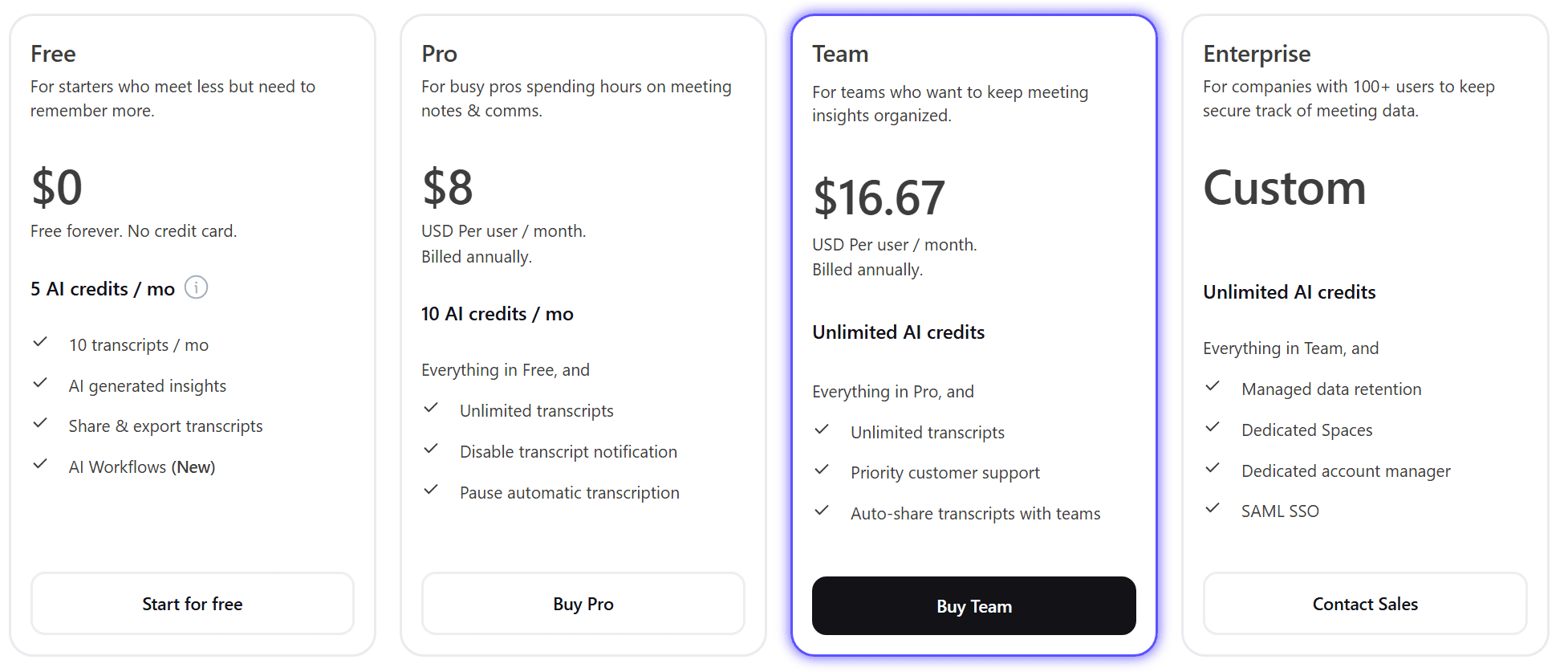
Tactiq has four plans:
- Free: $0
- Pro: $8
- Team: $16.67
- Enterprise: Custom pricing
All prices are per user per month when billed annually.
The free plan unlocks just 10 meetings per month and only 5 AI credits (used for summaries, notes, questions, and more). You also can’t prevent Tactiq from recording your calls on the free plan, which is a bit silly when you want to try and use the credits carefully.
The Pro plan provides unlimited transcripts but still a measly 10 AI credits per month. The Team plan is where you unlock unlimited AI credits, as well as priority customer support.
Enterprise unlocks features you’d expect like SAML-based SSO, customizable data retention, dedicated spaces, and a dedicated account manager.
Real User Feedback: What Do Tactiq’s Everyday Users Think?
Tactiq gets mixed reviews depending on which third-party review site you visit. On TrustPilot, for example, it scores a measly 2.6/5, whereas on ProductHunt and ChromeStore it gets 4.8/5 from more reviews. Here’s the full breakdown:
- On ProductHunt, Tactiq scores 4.8/5 from 46 reviews.
- On TrustPilot, Tactiq scores 2.6/5 from 5 reviews.
- On Capterra, it gets 4.4/5 from 5 reviews.
- On G2, it scores 4.5/5 from 13 reviews.
- On Google Chrome Store, Tactiq scores 4.8/5 from 2.6k reviews.
On average, led primarily by Google Chrome Store, Tactiq scores a weighted average of 4.79/5 from 2,669 reviews.
A TrustPilot review from February 2025 hits the nail on the head in terms of Tactiq’s transcription accuracy.
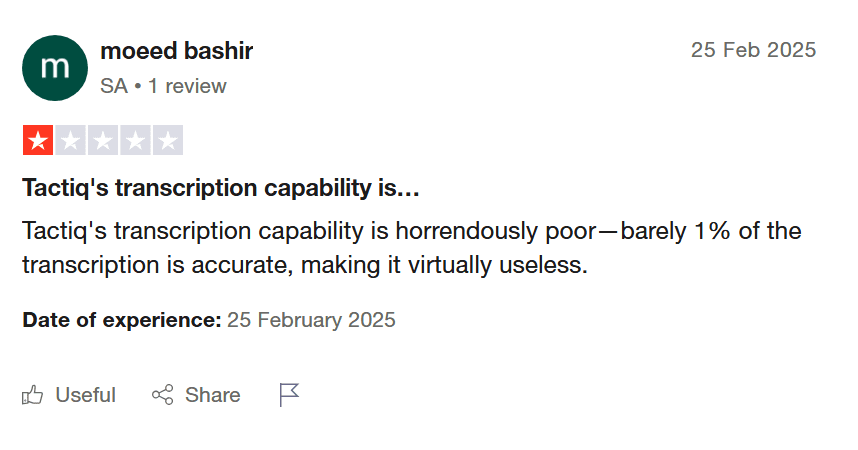
Moeed Bashir describes Tactiq’s transcription capability as “horrendously poor” with barely 1% of the transcription being accurate. He regards it as “virtually useless.”
However, there are plenty of Tactiq users that would disagree.
Antonio Miguel R. calls it “The best call transcription tool I have tried.” He goes on to say it’s “extremely easy to use” and “integrates very well with Google Meet and Zoom.” He also calls it “very accurate when transcribing the call,” something I’d have to disagree on.

Antonio’s least favorite part about Tactiq is the limited free plan. And that’s the big thing. Tactiq’s free plan is limited to just 10 transcriptions per month, and you cannot stop the tool from transcribing any meetings on the free plan, meaning you can’t prioritize which calls you want to use those 10 transcriptions on. A flawed system, in my opinion.
On the Chrome Store, Tactiq receives hundreds of 5 star reviews that are just a few words long. While this may not be suspicious, it definitely has me raising my eyebrows.

Make of these generic reviews what you will, the truth is that Tactiq’s free plan is good enough for a test run, but it’s not going to be reliable for monthly work.
5. Otter
Otter.ai has been a pioneer in AI-powered transcription and note taking for years. Its Basic (free) plan still offers solid foundations in 2025, though it increasingly feels like an entry-level experience compared to more ambitious meeting AI tools.
Unlike other AI meeting assistants, Otter doesn’t seem to be adapting to the curve very much. It’s put out a few sales-focused features, but nothing that truly makes the most of the meeting insights it gathers. Otter still has video recording boxed off in Enterprise which is just ludicrous in 2025.
All in all, while Otter is a solid choice for those just getting started with meeting transcription, its free plan isn’t able to compete with Otter alternatives like tl;dv, Fireflies, and Fathom.
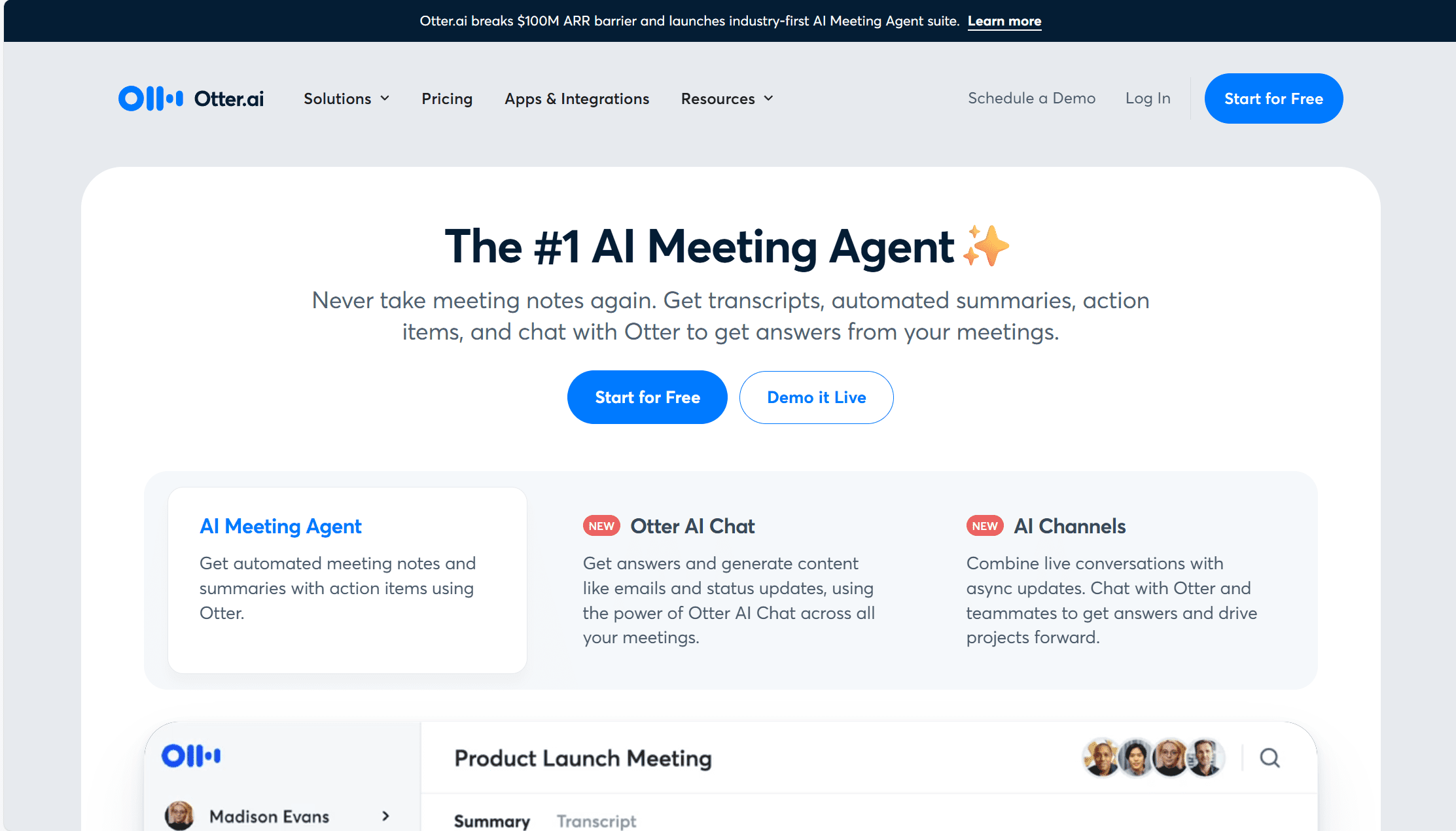
Free Plan Features
- AI meeting assistant records, transcribes and summarizes in real time
- Basic AI Meeting Templates
- Transcription in English, French and Spanish
- Otter AI Chat: Chat live with Otter and teammates, and get answers to meeting questions
- Add teammates to your workspace
- Joins Zoom, MS Teams, and Google Meet to automatically write and share notes
- 300 monthly transcription minutes; 30 minutes per conversation; Import and transcribe 3 audio or video files lifetime per user
As you can see, Otter’s free plan struggles to match the quality of other free AI note taker tools, but it’s not a bad place to get started.
Free Plan Drawbacks
- 300‑minute/month cap and 30-minute session limit is restrictive
- Limited to 3 imported files for transcription
- Only 3 supported languages, with no auto-detection
- No video playback, only transcript + screenshots
- Reported accuracy issues with multi-speaker settings and accents
- Limited AI capabilities
Otter’s free plan arguably has the most drawbacks out of this whole list of free AI note takers, yet thousands of people still use Otter on a day-to-day basis. We’ll see what they think in a moment.
Pricing and Upgrades: How Much Does Otter Cost?

Otter has four subscription tiers:
- Free ($0)
- Pro ($8.33)
- Business ($20)
- Enterprise (Custom)
All prices are per user per month, when billed annually.
I used the free plan and can speak from experience that the 30 minutes-per-conversation limit is the biggest drawback here, followed by the lack of video recording.
Otter’s Pro plan provides advanced AI meeting templates, some more Team features for enhanced collaboration, and advanced search options.
The Business plan offers more admin features, the ability to record concurrent meetings, and lifts all limits on audio or video file uploads.
The Enterprise plan offers the usual suspects like SSO, but also provides video playback and Otter Sales Agent.
It’s worth mentioning that none of these Otter plans provide unlimited transcription. tl;dv, Fireflies, and Fathom all provide this as part of their free offering.
To get more insights into Otter’s subscription model, check out our Otter pricing guide for 2025.
Real User Feedback: What Do Otter’s Everyday Users Think?
Despite not having any cutting edge features, paywalling video playback, and offering an average free plan, Otter still gets a lot of users. They must be doing something right. Let’s take a look at what everyday Otter users think.
- On G2, Otter scores 4.3/5 from 302 reviews.
- On ProductHunt, Otter scores 4.7/5 from 41 reviews.
- On Capterra, it gets 4.4/5 from 97 reviews.
- On TrustPilot, it scores3.8/5 from 482 reviews.
That gives Otter a total weighted average of 4.07/5 from 922 reviews.
This isn’t a bad score, but it’s certainly not a must-rush-out-and-buy-Otter score either. Brad P., CMO of a small business, said, “Solid tool, but we outgrew it.” I think that just about sums Otter up. It was good 5 years ago, but not much has changed.

Written in late May, 2025, Brad goes on to say he left Otter for Fathom because Otter had too many limitations. His team needed full video recording which Otter bizarrely paywalls behind their Enterprise plan, and he needed smarter summaries which Otter just cannot match.
He was disappointed by the limited monthly minutes, weak transcription accuracy “even in clean audio environments,” and “weak action item detection.” Most importantly, Brad says that Otter “transcribed what was said, but lacked the ability to understand the why or how, which limited its usefulness for deeper meeting insights.”
Over on G2, Haroon C. loves Otter and praises it for being “time-saving & accurate.”

Haroon particularly loves the real-time transcription, claiming it’s highly accurate (but failing to mention how awkward it is to read along to a real-time transcript that opens in a separate tab while paying attention during the actual call). He also lauds the searchable transcripts that boost productivity.
However, Brad didn’t give it a perfect score. He said that “sometimes the transcription accuracy drops with heavy accents or background noise.” He also criticized the free plan, claiming that it has “limited features” and that the AI summaries in particular could do with being more customizable.
All in all, Otter’s reviews are middle of the road. In our full review, we dive into more user feedback so feel free to check that one out. At the end of the day, Otter’s free plan is a little like Tactiq’s. It’s good enough to test the features of the tool, but not strong enough to actually use in any meaningful way.
Which Free AI Note Taker Tool Is Best For You?
Choosing a free AI note taker for you really depends on what you need it for, how often you’ll be using it, and whether you actually want to stay on the free plan, or just test it out before potentially upgrading.
In terms of value for money, tl;dv is the clear leader. It has unlimited transcription, unlimited AI moment summaries, and automatic language detection mid-call. It also lets you use the more advanced AI features 10 times per month, which is double that of Fathom.
Fireflies and Fathom are both solid options too, with Fathom’s free plan being particularly good for individuals, whereas Fireflies’ free plan lacks video recording but does include more Ask Fred AI capabilities.
Tactiq and Otter are not as good if you want a tool you can use reliably whenever you have a meeting. Their free plans are more for those who want to test out the tool before upgrading to a premium plan. However, most of what they offer in their paid plans are already provided by tl;dv, Fireflies, and Fathom in their free plans.
Ultimately, it depends on your tastes. All five of these tools have free plans that you can get started with today. If any of them have caught your eye, try them out today and test them for yourself. Reviews are great, but nothing beats raw experience. That’s what free plans are for!
FAQs About Free AI Note Taking Tools
What is the best free AI note taking tool in 2025?
If you’re after the most generous and feature-rich free plan, tl;dv is currently the clear winner. It offers unlimited video recordings, transcripts, and AI summaries across Google Meet, Zoom, and MS Teams—even if you don’t attend the meeting. Fireflies is a strong contender for audio upload users, and Fathom is great for solo users who want high quality action items.
Are free AI note takers actually usable, or just demos?
Some are just glorified trials, but not all. Tools like tl;dv, Fathom, and Fireflies offer genuinely useful free plans that don’t expire. Others, like Otter.ai and Tactiq, limit functionality or time quotas, making them more suitable for occasional use or as a stepping stone to paid plans.
Do any free AI note taking tools work even when you don't join the meeting?
Yes. tl;dv can auto-join your calls and take notes for you, even if you don’t show up—as long as your meeting admin allows the bot. This is especially useful for asynchronous teams or when you double-book.
Can I use these tools for in-person meetings or lectures?
Otter.ai is the best option for that. It supports real-time, in-person transcription via its mobile app, which is ideal for lectures, interviews, or voice memos. Most other tools focus exclusively on virtual meetings.
Are AI notes and summaries accurate?
Accuracy varies depending on speaker clarity, background noise, and platform. tl;dv and Fathom have some of the most accurate transcripts and summaries, especially when multiple speakers are involved. That said, no tool is perfect—always review important details before sharing or publishing.
Are there privacy concerns with these tools?
Yes, especially for enterprise teams or regulated industries. Most free tools store your recordings and transcripts in the cloud. Make sure the tool you’re using is GDPR-compliant and offers consent management (tl;dv and Fireflies both do). For sensitive data, it’s best to upgrade to a paid plan that includes better data controls.
Which tools work best for teams?
tl;dv and Fireflies offer team-friendly features like shared libraries, collaborative notes, and integrations with Slack, CRMs, and calendars. However, most of the real team power is locked behind paid plans.
Fathom is free for individuals only, so team use will require upgrading. According to real user reviews, Fathom’s team workspace is actually not that great as well, requiring you to log in to your colleagues dashboard to see their calls rather than displaying all team calls together.
Can I integrate these tools with my CRM?
Yes, but usually only on paid plans. tl;dv’s Pro plan integrates with over 5,000 tools, including Salesforce and HubSpot. Fireflies also supports CRM integrations starting from its Pro tier. On free plans, you’ll usually get calendar and Slack integrations only.

